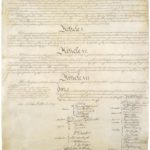The Seneca Falls Convention, held in Seneca Falls, New York, on July 19 to July 20, 1848, was the first women’s rights convention held in the United States. At that convention, the Declaration of Sentiments was written that outlined demands for women’s equality. This lesson uses video clips to have students understand the important people and events that led to the Declaration of Sentiments and then apply the text of the Declaration to today.
Court Packing vs. Reorganizing: The Supreme Court in the New Deal
This activity presents students with a 1937 letter written by newspaper publisher Frank Gannett opposing President Franklin Delano Roosevelt’s plan to “reorganize the judiciary” (also known as his “court-packing” plan). Students will read and analyze this letter to understand Gannett’s perspective on this controversial issue.
Major Events of the Cold War
In this lesson, students will use short video clips to learn about major events occurring during the Cold War, the causes of these events, and their impact on the U.S., Soviet Union, and the world. Students will summarize this information by providing a written response that analyzes the legacy of the Cold War.
Constitutional Index

The Constitutional Index breaks down the U.S. Constitution by Section, Amendment, and Clause and contains broader topics and themes. These are used to cross-reference Library resources in an effort to annotate constitutional history. Each index page displays a summary, a list of related resources in the ConSource library, and a guide to the selected topic if one has been written.
Constitutional Index – Amendment 25 Written Declarations Clause
The Constitutional Index breaks down the U.S. Constitution by Section, Amendment, and Clause and contains broader topics and themes. These are used to cross-reference Library resources in an effort to annotate constitutional history.
Forgotten Founders

This short video examines why some Founders have been “forgotten” by subsequent generations. Some individuals, like John Dickinson, found themselves “on the wrong side of history”. Others, like Samuel Adams, played no further role on the national stage. Professor Daniel Dreisbach explains how an early death (e.g. George Mason) or a minimal written record also contributed to some Founders being “forgotten.”
Our Constitution: A Conversation
Grade 9-12 The Dynamics of War Powers
This three-part lesson asks students to think critically about the nature of the War Powers identified by the Constitution. Beginning with the historical foundations of the War Powers as written in the Constitution, students will explore why the Founders identified the War Powers as they did, using primary sources to back up their arguments. Students will then consider how War Powers have changed over time, evaluating the evolving dynamic of powers between the three branches of government.
Our Constitution
The Our Constitution book, written by Donald A. Ritchie and JusticeLearning.org, takes an in-depth look at the Constitution, annotated with detailed explanations of its terms and contents. Included are texts of primary source materials, sidebar material on each article and amendment, profiles of Supreme Court cases, and timelines. The complete book or individual chapters can be downloaded.
Our Rights
The book Our Rights, written by David J. Bodenhamer, uses historical case studies to explore the rights in the Constitution. Supreme Court cases are used to demonstrate how a right received its modern interpretation, how the right applies today, and how courts and other interpreters seek to balance this right with important societal concerns such as public safety. The complete book or individual chapters can be downloaded.
